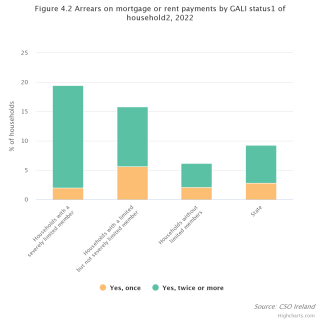People who report poor health more likely to be in poverty and deprivation
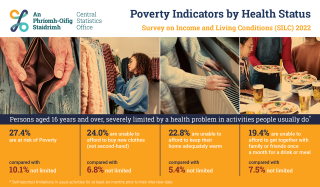
A recent publication from the Central Statistics Office looking at poverty status by health indicators shows that poverty rates and rates of enforced deprivation are higher in people who report a chronic illness and those who are severely limited in usual activities because of a health problem. The enforced deprivation rate was twice as high for those with a self-reported chronic illness when compared with those without a chronic illness. More than one in four (27.4%) people aged 16 years and older with long-standing severe activity limitations due to health problems were at risk of poverty in 2022.
Poverty Indicators by Health Status: key findings deprivation:
The main findings of the CSO Report 'Poverty Indicators by Health Status - Survey on Income and Living Conditions (SILC) 2022' on deprivation are:
People severely limited for at least six months in usual activities because of a health problem (measured by Global Activity Limitation Indicator (GALI)) had higher rates of deprivation for each of the 11 deprivation indicators when compared with those not limited. For example, more than one in five (22.8%) people who were ‘severely limited’ were unable to afford to keep their home adequately warm compared with 5.4% of people who were ‘not limited’.
In 2022, one in four (24.0%) people who were ‘severely limited’ were unable to afford new (not second-hand clothes) compared with 6.8% of people who were ‘not limited’. Almost one in five (19.4%) ‘severely limited’ people were unable to afford to get together once a month with family or friends for a drink or a meal. This compared with 7.5% of people ‘not limited’ in usual activities.
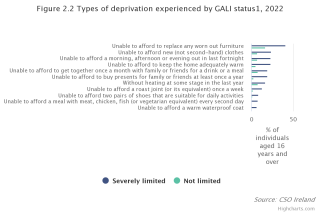
- The enforced deprivation rate in 2022 for ‘severely limited’ people was over ten percentages points higher than the 2021 rate (43.7% and 33.0% respectively).
- The enforced deprivation rate for people who were ‘limited but not severely’ was 27.6% in 2022 (up from 21.7% in 2021) and for those ‘not limited’ the 2022 rate was 13.4% (up from 10.2% in 2021).
- The enforced deprivation rate was twice as high for those with a self-reported chronic illness when compared with those without a chronic illness (27.4% and 13.0% respectively).
Enforced deprivation
Enforced deprivation is where a household experiences two or more of the 11 deprivation items.
- The national enforced deprivation rate for people aged 16 years and older was 17.3% in 2022.
- The enforced deprivation rate for people who described their health in general as ‘very bad’ was more than three times higher than the rate for those with ‘very good’ health (42.9% and 12.2% respectively).
- The enforced deprivation rate was twice as high for those with a self-reported chronic illness when compared with those without a chronic illness (27.4% and 13.0% respectively).
- In 2022, more than four in ten (43.7%) people who described themselves as ‘severely limited’ in usual activities were living in enforced deprivation. This compares with 27.6% of people who were ‘limited but not severely’ and 13.4% of those ‘not limited.
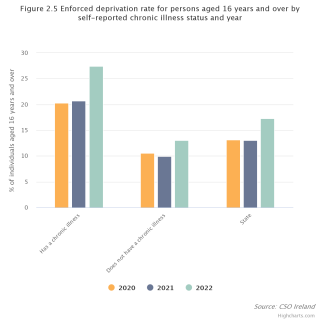
Poverty Rates by Self-Reported Health status
- The 2022 national at risk of poverty rate for people aged 16 years and older was 12.7%, up from 11.3% in 2021.
- The rate for people with a self-reported chronic illness was 18.6%, compared with 10.3% for those without a chronic illness.
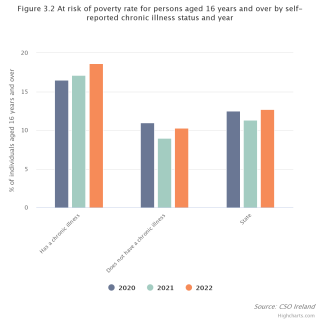
- The at risk of poverty rate for people who perceived their health as ‘very bad’ was almost four times higher than the rate for those with a ‘very good’ perception of their health (30.4% and 8.0% respectively).
- More than one in four (27.4%) people who were ‘severely limited’ in usual activities were at risk of poverty in 2022. The comparable rate for those ‘limited but not severely’ was 21.1%, and 10.1% for those who were ‘not limited’.
- In 2022, 4.9% of the people aged 16 years and older were living in consistent poverty. Consistent poverty is defined as people who are both at risk of poverty and experiencing enforced deprivation. People with severe limitations are four times more likely to be living in consistent poverty as those with no limitations (14.1% compared to 3.5%).
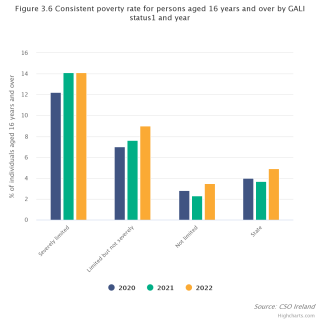
Arrears in Utility Bills
In 2022, 5.9% of households reported great difficulty in making ends meet. The rate for households with a ‘severely limited’ household member was 17.9% and 3.8% for households where all household members were ‘not limited’. One in five (20.5%) households with a person severely limited in usual activities for a period of at least six months reported that there was at least one occasion in the past 12 months where they failed to pay a utility bill on time due to financial difficulties. The comparable rate for households where all household members were ‘not limited’ was 7.1%.
4.9% of households with a ‘severely limited’ member fell into arrears on utility bill payments on one occasion, with a further 15.6% failing to make a utility bill payment by due date on two or more occasions.
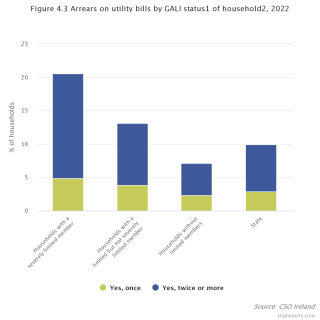
Households were asked the extent to which housing costs (rent, mortgage, utility costs, home insurance, and regular maintenance and repair costs) were a burden. Almost half (49.7%) of households with a ‘severely limited’ household member considered housing costs a heavy burden. This was almost double the rate for households where all household members were ‘not limited’ (25.5%).
Analysis of households owned with a mortgage or rented, where at least one household member was ‘severely limited’ shows that in the 12-month period prior to their date of interview, 2.0% of these households failed once and a further 17.5% failed twice or more to make their mortgage/rent payment on time. The comparable rates for households without limited members were 2.1% (failed once) and 4.1% (failed twice or more).
